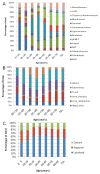Soft tissue sarcoma across the age spectrum: a population-based study from the Surveillance Epidemiology and End Results database
- PMID: 21793180
- PMCID: PMC4261144
- DOI: 10.1002/pbc.23252
Soft tissue sarcoma across the age spectrum: a population-based study from the Surveillance Epidemiology and End Results database
Abstract
Background: Soft tissue sarcomas (STS) are a heterogeneous group of mesenchymal malignancies that occur throughout the lifespan. The impact of age on disease features and outcome is unclear.
Methods: We analyzed the clinical features and outcome of all STS cases registered between 1973 and 2006 in the SEER database.
Results: There were 48,012 cases that met the selection criteria. Individuals less than 20 years of age represented 5.6%, with rhabdomyosarcoma being the most common subtype. In adults, the most common types were Kaposi sarcoma, fibrohistiocytic tumors, and leiomyosarcoma. Rhabdomyosarcoma was the only entity with a median age <20 years. Male predominance (male/female of 1.5:1) was noticed for almost all types of STS, except for alveolar soft part sarcoma and leiomyosarcoma. Tumor stage was similar across different age groups. Younger patients (<50 years) had significantly better survival than older patients (88.8 ± 0.2% vs. 40 ± 0.3%, P < 0.001), but for most histologies the survival decline with advancing age was gradual and did not occur abruptly at the onset of adulthood. The decline in survival with advancing age was particularly significant for rhabdomyosarcoma.
Conclusion: With few exceptions, the clinical features of STS are similar in children and adults. However, individuals over 50 years of age have an inferior survival.
Copyright © 2011 Wiley-Liss, Inc.
Conflict of interest statement
The authors have no financial interest or conflict of interest to declare.
Figures

References
-
- Weiss S, Goldblum J. General considerations. In: Weiss S, Goldblum J, editors. Enzinger and Weiss’s Soft Tissue Tumors. St Louis, Missouri: CV Mosby; 2001. pp. 1–19.
-
- National Cancer Institute. Surveillance, Epidemiology, and End Results (SEER) Program Public-Use Data (1973–2006) National Cancer Institute, DCCPS, Surveillance Research Program, Cancer Statistics Branch; released April 2009, based on the November 2008 submission. www.seer.cancer.gov.
-
- Surveillance, Epidemiology, and End Results (SEER) Program. National Cancer Institute, DCCPS, Surveillance Research Program, Cancer Statistics Branch; SEER*Stat Database: Incidence - SEER 9 Regs Limited-Use, Nov 2008 Sub (1973–2006) <Katrina/Rita Population Adjustment> - Linked To County Attributes - Total U.S., 1969–2006 Counties. ( www.seer.cancer.gov) released April 2009, based on the November 2008 submission.
-
- Levi F, Randimbison L, Te VC, et al. Kaposi’s sarcoma in Vaud and Neuchatel, Switzerland, 1978–2002. Eur J Cancer. 2004;40(10):1630–1633. - PubMed
-
- Rouhani P, Fletcher CD, Devesa SS, et al. Cutaneous soft tissue sarcoma incidence patterns in the U.S. : an analysis of 12,114 cases. Cancer. 2008;113(3):616–627. - PubMed
MeSH terms
Grants and funding
LinkOut - more resources
Full Text Sources
Medical
Miscellaneous

